
Piazza San Marco, often known in English as St Mark's Square, is the principal public square of Venice, Italy, where it is generally known just as la Piazza. The Piazzetta is an extension of the Piazza towards San Marco basin in its southeast corner. The two spaces together form the social, religious and political centre of Venice and are referred to together. This article relates to both of them.
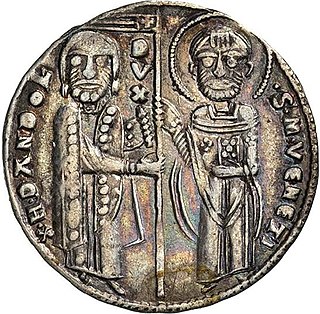
Enrico Dandolo was the doge of Venice from 1192 until his death in 1205. He is remembered for his avowed piety, longevity, and shrewdness, and his role in the Fourth Crusade and the Sack of Constantinople. Dandolo died in 1205 in Constantinople and was buried at the Hagia Sophia.

The Patriarchal Cathedral Basilica of Saint Mark, commonly known as St Mark's Basilica, is the cathedral church of the Patriarchate of Venice; it became the episcopal seat of the Patriarch of Venice in 1807, replacing the earlier cathedral of San Pietro di Castello. It is dedicated to and holds the relics of Saint Mark the Evangelist, the patron saint of the city.
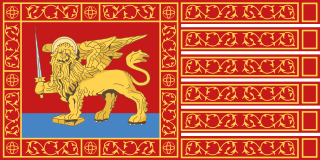
The Republic of Venice, officially the Most Serene Republic of Venice and traditionally known as La Serenìssima, was a sovereign state and maritime republic with its capital in Venice. Founded, according to tradition, in 697 by Paolo Lucio Anafesto, over the course of its 1,100 years of history it established itself as one of the major European commercial and naval powers. Initially extended in the Dogado area, during its history it annexed a large part of Northeast Italy, Istria, Dalmatia, the coasts of present-day Montenegro and Albania as well as numerous islands in the Adriatic and eastern Ionian seas. At the height of its expansion, between the 13th and 16th centuries, it also governed the Peloponnese, Crete and Cyprus, most of the Greek islands, as well as several cities and ports in the eastern Mediterranean.

The bucentaur was the ceremonial barge of the doges of Venice. It was used every year on Ascension Day up to 1798 to take the doge out to the Adriatic Sea to perform the "Marriage of the Sea" – a ceremony that symbolically wedded Venice to the sea.
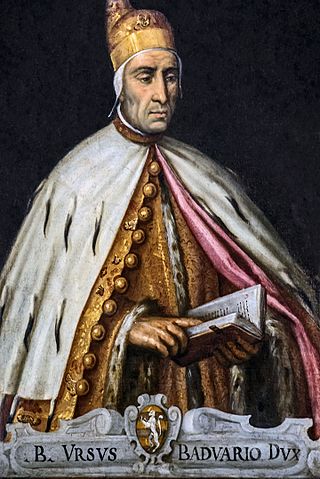
Orso II Participazio was the eighteenth doge of the Republic of Venice, by tradition, from 912 to 932.

Leonardo Loredan was a Venetian nobleman and statesman who reigned as the 75th Doge of Venice from 1501 until his death in 1521. As a wartime ruler, he was one of the most important doges in the history of Venice. In the dramatic events of the early 16th century, Loredan's Machiavellian plots and cunning political manoeuvres against the League of Cambrai, the Ottomans, the Mamluks, the Pope, the Republic of Genoa, the Holy Roman Empire, the French, the Egyptians and the Portuguese saved Venice from downfall.

Agostino Barbarigo was Doge of Venice from 1486 until his death in 1501.

Pietro I Orseolo OSBCam, also known as Peter Urseulus, (928–987) was the Doge of Venice from 976 until 978. He abdicated his office and left in the middle of the night to become a monk. He later entered the order of the Camaldolese Hermits of Mount Corona. He is venerated as a saint in the Eastern Orthodox Church and Roman Catholic Church.
Pietro IV Candiano (925–976) was the twenty-second (traditional) or twentieth (historical) doge of Venice from 959 to his death. He was the eldest son of Pietro III Candiano, with whom he co-reigned and whom he was elected to succeed.

Alvise Sebastiano Mocenigo (1662–1732), sometimes enumerated Alvise III Mocenigo, was the 112th Doge of Venice from 1722 to 1732. He was also Provveditore Generale (Governor) of Venetian Dalmatia twice.
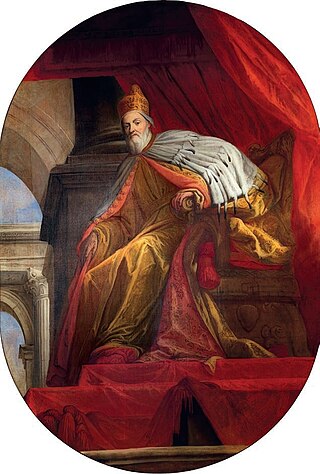
Giovanni I Corner or Cornaro was the 96th Doge of Venice from 4 January 1625 until his death in 1629.
This article presents a detailed timeline of the history of the Republic of Venice from its legendary foundation to its collapse under the efforts of Napoleon.

The Fisherman Presenting the Ring to Doge Gradenigo is a 1534 oil-on-canvas painting by the Venetian Renaissance painter Paris Bordone (1495–1570). It was painted in Venice for the confraternity of San Marco in 1540. The painting treats the legend behind the tempest that struck Venice on 15 February 1340. It depicts a gondolier returning the ring of Saint Mark to the Doge Bartolomeo Gradenigo.

Fosca is an opera seria in four acts by Brazilian composer Antônio Carlos Gomes to an Italian-language libretto by Antonio Ghislanzoni based on Luigi Capranica's 1869 novel La festa delle Marie.

The Lion of Saint Mark, representing Mark the Evangelist, pictured in the form of a winged lion, is an aspect of the Tetramorph. On the pinnacle of St Mark's Cathedral he is depicted as holding a Bible, and surmounting a golden lion which is the symbol of the city of Venice and formerly of the Venetian Republic.
Isabella Fieschi, was a lady of Milan by marriage to Luchino Visconti, lord of Milan.
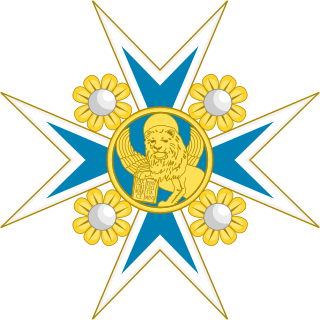
The Order of Saint Mark was the sole order of chivalry of the Republic of Venice. It was named in honour of Venice's patron saint, Mark the Evangelist.

The Flag of the Republic of Venice, commonly known as the Banner or Standard of Saint Mark, was the symbol of the Republic of Venice, until its dissolution in 1797.
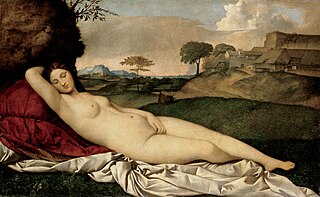
The Venetian Renaissance had a distinct character compared to the general Italian Renaissance elsewhere. The Republic of Venice was topographically distinct from the rest of the city-states of Renaissance Italy as a result of their geographic location, which isolated the city politically, economically and culturally, allowing the city the leisure to pursue the pleasures of art. The influence of Venetian art did not cease at the end of the Renaissance period. Its practices persisted through the works of art critics and artists proliferating its prominence around Europe to the 19th century.

















